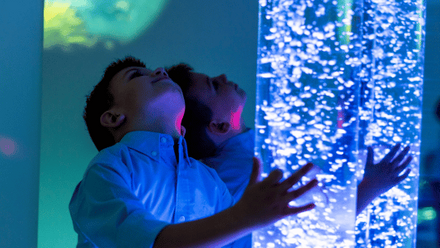Considering the physical environment
The physical environment is one that surrounds us all – literally! For the majority of professionals, it is the space we inhabit throughout our working day and, for the children in our care, the place in which they learn and grow with us throughout their early years.
Unlike daily provisions that we can adapt throughout the day, such as through in-the-moment planning methods, to extend or develop on learning opportunities, the physical environment can be a little more static. From visual displays to the ways we utilise furniture, the physical environment can revolutionise how we use a space.
This learning workout aims to explore some of the ways to change up the physical environment. We’ve also provided a handy personal log for you to download, to think about how you currently use your physical environment and how you might make future improvements.
The physical environment matters
The words “physical” and “environment” often lend themselves to thoughts about the outdoor world, such as the garden space and outdoor play and learning. But, in this resource, we want to spend some time thinking about how the indoor environment is used from a physical perspective. This lends itself to so many exciting opportunities that are often deprioritised due to the busy and dynamic nature of working with children in early education and care. Renovating display boards, updating photos or rearranging furniture can often fall by the wayside when things get busy in the setting.
Despite the time investment required to make ongoing improvements to the physical environment, the benefits really can pay off. Between the physical surroundings and sensory effects within them, research suggests that our surroundings can have a huge impact on our emotional wellbeing, as well as children’s behaviour and their ability to regulate within that space. emotional wellbeing, as well as children’s behaviour and their ability to regulate throughout the space.
Thinking about physical space
Keeping it stimulating…
Every day is a new adventure, where young children are discovering fascinating new skills that they couldn’t quite recognise just the day before. Providing a stimulating environment is a multi-faceted conversation but the physical environment can play a core role to its further development. Think big! Move furniture around to rejuvenate a tired space. Why not work with colleagues to swap some furniture with other rooms to provide a novel addition to your space, whilst shaking up someone else’s room too? Whether it's adding some new cutlery and blankets to a cosy corner, swapping around cupboards, or removing all of the chairs for a day, thinking about ways to change the physical environment can prompt a range of new discussions and engagements.
…whilst remaining secure and familiar.
To support children’s regulation and sense of belonging, it’s a good idea to make small changes that ensure children continue to recognise their space and feel secure within it. Making radical changes can cause distress for young children who might feel out of place in a totally different environment. Keep bold colours to a minimum and refrain from too many new additions that could cause an overwhelming sensory experience. Be mindful of the colours that are used and the noise in the space when you make changes to ensure children feel just as comfortable in their newly renovated environment as they did before.
Providing moments that spark curiosity…
Young children are naturally inquisitive and part of our special role in supporting their development, involves harnessing this unique power to ask why. Providing a physical environment that supports curiosity is one that is key to lending moments of independent enquiry that, in turn, produce valuable learning opportunities for children to explore.
Utilise the physical environment to prompt new ways of engaging with provocations. Mix the dinosaurs with the bricks, lend the dolls to the water tray – think of new ways to move items from their ‘home’ roleplay environment to a new area of the room, sparking curiosity and challenging familiar play in rich ways.
…whilst showing children routine and stability.
But, of course, it is important to maintain a sense of routine and establish boundaries for safe play and respectful conduct to others. The physical environment can still be used to demonstrate these valuable skills by establishing physical boundaries for intimate care, such as shutting doors when using the toilet, or hygienic routines for food times that incorporate the space into practice when washing hands, cleaning away and even eating too.
Physical environments matter!
There’s a huge range of ways we can think about the physical environment and this article has touched on just a few ideas to get you thinking about how you organise your indoor space. You can expand on all of these by thinking more particularly about the age of the children you work with and the niches of your setting’s physical structure.


